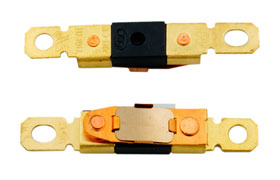The second type: porcelain tube type thermal fuse
It is composed of an axisymmetric lead, a fusible alloy that can be melted at a specified temperature, a special compound to prevent its melting and oxidation, and an insulating porcelain insulator. When the ambient temperature rises, the specific resin mixture begins to liquefy. When the melting point is reached, with the help of the resin mixture (increasing the surface tension of the melted alloy), the melted alloy rapidly shrinks into a ball centered on the leads at both ends under the action of surface tension, so as to permanently cut off the circuit.
The third type: square shell Thermal Cutoffs
A section of fusible gold wire is connected between the two pins of the temperature fuse, and the special resin is coated with the fusible gold wire. The current can flow from one pin to another. When the temperature around the temperature fuse rises to its operating temperature, the fusible alloy melts and shrinks into a ball at the ends of the two pins under the action of surface tension and the help of special resin. In this way, the circuit is permanently cut off.
It also has some disadvantages. Firstly, it is unrecoverable. It is not as good as PTC. Even if an accidental fault causes PTC action, once the fault is eliminated, the battery can continue to work. Once the temperature fuse acts, the whole battery can no longer work. Of course, with the quality of lithium-ion batteries getting better and better, the probability of this accidental failure is getting smaller and smaller. Once an abnormality occurs, the battery will not be allowed to continue to use, but it has become the advantage of temperature fuse. After all, the cost of a battery is minimal compared with personal injury events. As the saying goes, we'd rather kill by mistake than let go. As long as the cell phone battery has a high-temperature failure, who dares to put this potential bomb around? Second, it cannot be welded and processed in ordinary ways, such as PPTC, which can withstand high temperature for a short time. Therefore, it can be welded in reflow furnace and directly injected into the battery. However, the temperature fuse can only be locally welded such as spot welding and laser welding to prevent the temperature fuse from fusing.
At present, 98 ℃ and 92 ℃ thin temperature fuses are widely used. Under the heating rate of 1 ℃ / min, the fusing temperature of 98 ℃ thin temperature fuse is 94 ± 3, and that of 92 ℃ thin temperature fuse is 89 + 3 / - 4, i.e. 85 ℃ ~ 92 ℃. Domestic manufacturers have been developing thin temperature fuses with higher fusing temperature. Temperature fuses can be divided into:











